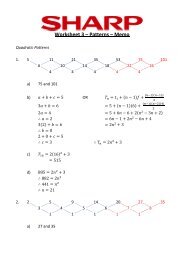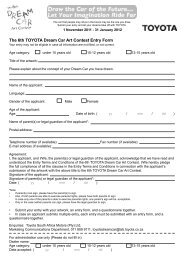curriculum and assessment policy statement (caps) - Department of ...
curriculum and assessment policy statement (caps) - Department of ...
curriculum and assessment policy statement (caps) - Department of ...
- No tags were found...
Create successful ePaper yourself
Turn your PDF publications into a flip-book with our unique Google optimized e-Paper software.
Content AreaContentClarification / Notes / Activities / ExamplesConcrete using 3-D objectsLet the learners sit on the carpet <strong>and</strong> provide each learner with a number <strong>of</strong>counters. Learners should each have a different number <strong>of</strong> counters.Let the learners put the counters out in front <strong>of</strong> them. The teacher asks thelearners:‣ Who has the most counters?‣ Who has the least counters?‣ Which learners have the same number <strong>of</strong> counters?CountersRecommended ResourcesApproximateDurationSuggested FormaAssessmentShape <strong>and</strong>SpaceMake <strong>and</strong> complete own 4-piece puzzleThis activity can be integrated with an art activity. Teacher takes learners’drawings<strong>and</strong> draws four lines on the back. Learners must cut on the lines <strong>and</strong> should havefour pieces. They must put the four pieces togetherto build their own puzzle.Learners own drawings1 dayMeasurementRecognise <strong>and</strong>exploreobjects that slideSequence events withinone day• Introduce objects that can slide‣ Provide learners with a variety <strong>of</strong> different shapes <strong>and</strong> sizes <strong>of</strong>blocks,boxes, balls, etc. <strong>and</strong>‣ Allow learners to experiment through play by seeing which objects canslide <strong>and</strong> which objects can roll.‣ The learners can use the slide in the playground or the teacher can usea table to make a slope by placing 2 blocks underneath it.‣ Can any <strong>of</strong> the objects slide upwards?‣ Which objects slide downwards?‣ Why are these objects able to slide?• Develop an awareness <strong>of</strong> what happens between suppertime <strong>and</strong>bedtime.BlocksBallsBoxesSlide / Table with blocks1 day1 dayLet the learners:‣ Talk about what they do after they havehad supper.‣ Talk about what happens at home after suppertime.Pictures that show what happens from suppertime tobedtime.The teacher asks:‣ ‘’Do you come to school in the morning or evening?”‣ If Peter gets to school after the bell has rung, is Peter late or early forschool?‣ Where is the sun at night?”Semi-concrete using 2-D shapes‣ Learners draw a picture to show any event after supper.Paper <strong>and</strong> crayonsNote:The learners should be able to complete at least a 12- piece puzzle at the end <strong>of</strong> term 2.37 | Page
















